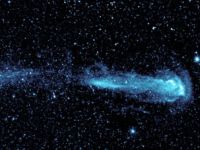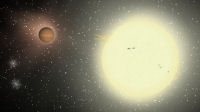 NASA’s SOHO website has a weekly feature that highlights selected solar events. This week’s SOHO Pick of the Week is about a video taken by one of the STEREO Spacecraft pair. STEREO consists of two space-based observatories – one ahead of Earth in its orbit, the other trailing behind. The video reveals a recent “shower of sparks” event on the sun’s surface. The circled region in the inset is where to look when playing the 36-second video embedded below:
NASA’s SOHO website has a weekly feature that highlights selected solar events. This week’s SOHO Pick of the Week is about a video taken by one of the STEREO Spacecraft pair. STEREO consists of two space-based observatories – one ahead of Earth in its orbit, the other trailing behind. The video reveals a recent “shower of sparks” event on the sun’s surface. The circled region in the inset is where to look when playing the 36-second video embedded below:
Astronomy
A Real Shooting Star
 Cal Tech Astronomers using the GALEX telescope, made a very interesting and unprecedented discovery of a massive tail being left in the trail of a well-known star, Mira. The faint tail, seen in ultraviolet light, spans more than 13 light years in the wake of Mira. The discovery of this phenomenon includes a ‘bow-shock’ ahead of the star, analogous to a vessel underway on the sea.
Cal Tech Astronomers using the GALEX telescope, made a very interesting and unprecedented discovery of a massive tail being left in the trail of a well-known star, Mira. The faint tail, seen in ultraviolet light, spans more than 13 light years in the wake of Mira. The discovery of this phenomenon includes a ‘bow-shock’ ahead of the star, analogous to a vessel underway on the sea.
Mira, a late-sequence red-giant star, is shedding it’s outer layers as it hurtles through the universe at amazingly high speeds (relative to our Sun). As scientists study this interesting discovery, they are likely to learn more about the ultimate destiny of our own star, which, as we know, will be similar to Mira in about five billion years.
From Science@NASA:
August 15, 2007: Astronomers using a NASA space telescope, the Galaxy Evolution Explorer, have spotted an amazingly long comet-like tail behind a star streaking through space. The star, named Mira after the Latin word for “wonderful,” has been a favorite of astronomers for about 400 years, yet this is the first time the tail has been seen.
Galaxy Evolution Explorer–“GALEX” for short–scanned the popular star during its ongoing survey of the entire sky in ultraviolet light. Astronomers then noticed what looked like a comet with a gargantuan tail. In fact, material blowing off Mira is forming a wake 13 light-years long, or about 20,000 times the average distance of Pluto from the sun. Nothing like this has ever been seen before around a star.
NASA and JPL/Caltech prepared a half-minute animation which is an artist’s conception of Mira generating her tail. Be sure and watch this neat little video.
Solar Spicules
Huge spikes of plasma fly out of the Sun’s surface all the time, according to scientists studying observations made by SOHO and STEREO spacecraft. This week’s SOHO Pick of the Week discusses these spikes in scientific terms, although there is still considerable question as to their nature and effects, especially about how they affect the planets — ours in particular.
I’m thankful for the ongoing study of the Sun. The more we learn about it, the more we will be able to refute the hysterical Greenbat nonsense about man-made global warming .
Breaking News! James Hansen’s Fake Temperature Algorithms
From SOHO Pick of the Week:
A close up view of the top of the Sun as seen in profile shows thousands of little spurts, like small blow torches, shooting out all over the Sun. The movie shows just an average day’s worth of this kind of activity as seen from the STEREO spacecraft (Ahead) in extreme ultraviolet light (August 3, 2007). These spurts are called spicules. With STEREO’s 2048×2048 image resolution and an image every 10 minutes, we can zoom in on features like this with no distortion. Spicules are plasma jets that shoot through the Sun’s atmosphere or corona at about 90,000 kilometers per hour. Discovered in 1877 by Angelo Secchi, they remain largely unexplained, in part because observations are difficult for objects with a brief life (about 5 minutes) and relatively small size (diameters of just 300 miles / 500 kilometers). They are caused by shock waves formed when sound waves at the solar surface leak into the solar atmosphere. More than 100,000 spicules occur at any given time on our star’s surface.
Watch the video below for a dynamic look at Solar Spicules.
Large Exoplanet Discovered by Lowell Astronomers
 For several years, Damsel and I have been contributing members of Lowell Observatory on Mars Hill near Flagstaff, Arizona. We occasionally visit them and always enjoy the museum and tours.
For several years, Damsel and I have been contributing members of Lowell Observatory on Mars Hill near Flagstaff, Arizona. We occasionally visit them and always enjoy the museum and tours.
Recently, Lowell Astronomers made a discovery of a very large, but low-density planet, orbiting a distant star. The planet should be smaller and more compact, according to physics, but it is a nebulous, oversized lightweight ball.
Image above courtesy Lowell Observatory: Artist conception of TrES-4 and it’s host star. Click on the thumbnail image to view the high-resolution artwork.
From Lowell Observatory:
August 6, 2007
Largest Transiting Extrasolar Planet Found Around A Distant Star
Flagstaff, Ariz.– An international team of astronomers with the Trans-atlantic Exoplanet Survey announce today the discovery of TrES-4, a new extrasolar planet in the constellation of Hercules. The new planet was identified by astronomers looking for transiting planets – that is, planets that pass in front of their home star – using a network of small automated telescopes in Arizona, California, and the Canary Islands. TrES-4 was discovered less than half a degree (about the size of the full Moon) from the team’s third planet, TrES-3.
“TrES-4 is the largest known exoplanet,” said Georgi Mandushev, Lowell Observatory astronomer and the lead author of the paper announcing the discovery. “It is about 70 percent bigger than Jupiter, the Solar System’s largest planet, but less massive, making it a planet of extremely low density. Its mean density is only about 0.2 grams per cubic centimeter, or about the density of balsa wood! And because of the planet’s relatively weak pull on its upper atmosphere, some of the atmosphere probably escapes in a comet-like tail.”
The Great 1991 Solar Eclipse – 16 Years Ago Today
Less than 1500 km from home, and I didn’t go! I kicked myself mentally for days after that, knowing that I had missed one of the more spectacular astronomical events in my lifetime. I did watch the partial eclipse visible from my location near LAX with an improvised helioscope made from an old set of binoculars and a cardboard box. It was OK, but when I heard the reports coming in from friends who were in Cabo San Lucas at the tip of Baja, California, I kicked myself again.
From Fred Espenak (Mr. Eclipse):
The Experience of Totality is one never to be forgotten. In the last seconds as totality begins, the daytime sky is quickly replaced by an eerie twilight as the Moon’s shadow sweeps across the landscape at speeds in excess of 1,200 mph. The bright Sun is suddenly extinguished and in its place stands the pitch black disk of the Moon surrounded by the gossamer, ethereal solar corona. All too quickly, totality ends and you realize you must see another one!
The next opportunity for totality in North America will be in August of 2017, following a path from Oregon to South Carolina: Continue reading…
Not So Long Ago in a Galaxy Not So Far Away
What if someone told you that planet Earth originated in another Galaxy and that the Milky Way caught us up in a gravitational sweep? What if they told you that the climate cycles on planet Earth were largely due to this galactic collision? Sound crazy? Maybe not . . .
Hat tip to my colleague, Rick, who sent this to me.
From ViewZone.com:
Using volumes of data from the Two-Micron All Sky Survey (2MASS), a major project to survey the sky in infrared light led by the University of Massachusetts, the astronomers are answering questions that have baffled scientists for decades and proving that our own Milky Way is consuming one of its neighbors in a dramatic display of ongoing galactic cannibalism. The study published in the Astrophysical Journal, is the first to map the full extent of the Sagittarius galaxy and show in visually vivid detail how its debris wraps around and passes through our Milky Way. Sagittarius is 10,000 times smaller in mass than the Milky Way, so it is getting stretched out, torn apart and gobbled up by the bigger Milky Way.
Image (David Law/University of Virginia): A new infra red digital survey of the entire sky was made in 2003. Teams from the universities of Virginia and Massachusetts used a supercomputer to sort through half a billion stars to create a — NEW STAR MAP showing our Solar System (yellow dot) to be at the exact nexus crossroads where two galaxies are actually joining.
. . .
It has been postulated that this is the real reason for both global warming since higher energy levels of the Milky Way are almost certain to cause our Sun to burn hotter and emit higher energies. Indeed, temperatures have been seen to rise on virtually all the planets in our system. This seems quite apart from any local phenomenon like greenhouse gases etc.
Watch the animation and read about other effects being observed in our solar system:
Just What Is A Blue Moon?
 Tomorrow night, when the full moon rises over North America, it is believed that this will be a “blue moon.” The modern definition for “blue moon” is the second full moon to occur within a calendar month and tomorrow’s full moon will indeed be the second to occur in the month of May, 2007.
Tomorrow night, when the full moon rises over North America, it is believed that this will be a “blue moon.” The modern definition for “blue moon” is the second full moon to occur within a calendar month and tomorrow’s full moon will indeed be the second to occur in the month of May, 2007.
Cartoon Image courtesy of NASA.
But hold on – Sky and Telescope magazine retracted it’s 1946 second-in-a-month definition in favor of stating that the “blue moon” is actually based on the four seasons and is the fourth full moon to occur within a season (Winter, Spring, Summer and Autumn). Using this definition, a “blue moon” may or may not occur within a calendar month.
It gets even more confusing.
